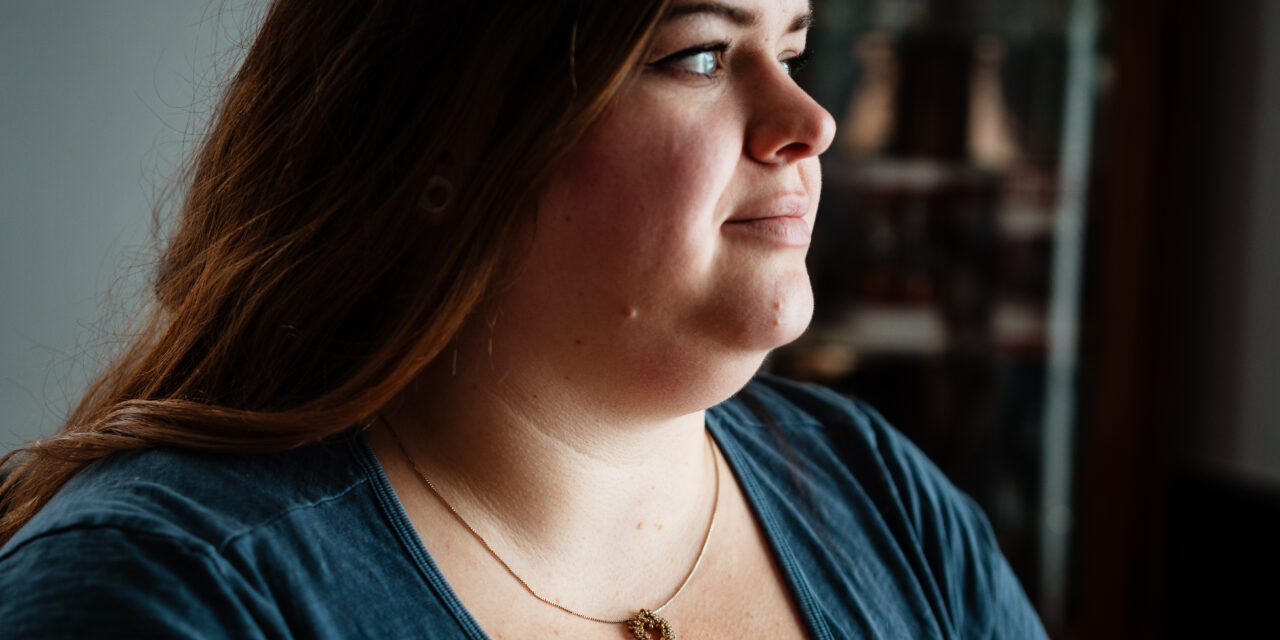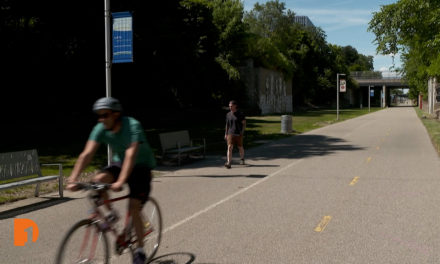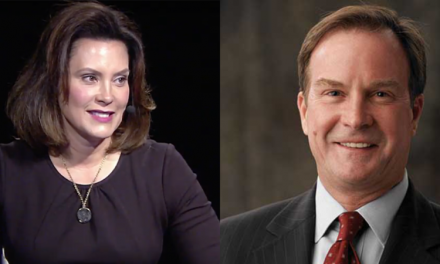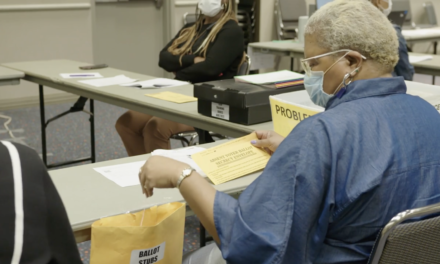By Julie Mack, Watershed Voice
Claudia Holewinski was 16 and her sister Marilyn was 24 when their mother, Mary Beth, was diagnosed with leukemia.
Their lives changed overnight.
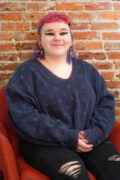
Claudia Holewinski was 16 when her mother was diagnosed with leukemia. She and her sister spent significant stretches over the next 14 months as primary caretakers for their mother, until her death. | Photo Credit: Taylor Scamehorn, Southwest Michigan Journalism Collaborative
Mary Beth Holewinski was a Kalamazoo single mother whose extended family lived on the east side of the state. That meant Marilyn and Claudia spent significant stretches over the next 14 months as primary caretakers for their mother, until her death in March 2018.
At the time her mother was diagnosed, Marilyn Holewinski Cole was living in Detroit. “First thing, I quit my job and my boyfriend, who’s now my husband, quit his job and we moved to Kalamazoo” to live with her mom and sister, Marilyn said.
Because Mary Beth had a bone marrow transplant, “we had to keep everything as clean as possible,” Marilyn said. “I also managed her medications, her diet and then she had a port in her chest, so I had to change bandages and things like clean up any messes that happened.
“She declined really fast” in the final months, Marilyn said. “She couldn’t do much. Couldn’t do laundry or walk up or downstairs alone. I would go home from work on my lunch to make sure she was OK and change her bandages.”
Meanwhile, Marilyn was working full time – somebody had to pay the bills, since cancer forced
Mary Beth to quit her job – and Claudia was a high school student with a part-time job.
It was overwhelming for both young women, who also were trying to process the fact that their mother was dying.
“It pretty much killed my mental health,” Marilyn said.
Their situation was not unique.
One in five American adults serves as an unpaid caregiver for family members or other individuals with physical or mental health issues, according to a 2020 report issued by the National Alliance for Caregiving and AARP.
The average age of a caregiver is 49, but about 24% of adult unpaid caregivers — almost 13 million Americans — are 18 to 34, the report said.
And that doesn’t include another 5.4 million adolescents who are unpaid caregivers, says a report from the American Society on Aging.
More than half of caregivers under 18 are supporting a parent, the report says, although some are caring for a grandparent, sibling or even a non-relative.
Before the pandemic, young caregivers received little attention from policymakers. Yet they experience higher levels of social isolation, depression, anxiety, and absenteeism from school in comparison to their non-caregiving peers, and the pandemic only exacerbated those pain points.
A recent survey of caregivers under age 30, commissioned by the New York-Michigan Solutions Journalism Collaborative, found 53% said that caregiving had taken a toll on their mental and/or physical health.
“There are not great supports out there for caregivers” of any age – and that’s especially true for teenagers and young adults cast in that role, said Susan Davis, a supervisor with Family & Children Services, a Kalamazoo nonprofit that provides behavioral health, child welfare and crisis intervention services.
“I can’t imagine being a young person just learning how to do things for themself and now having to do that for a parent,” Davis said. “They kind of end up putting their lives on hold.”
There’s an app for that
There are potential solutions in addressing the mental health stresses. One example is the Me-We program model designed by a cross-national European team to provide support for young caregivers, known in Europe as “carers.”
Available in the United Kingdom, Sweden, the Netherlands, Switzerland, Italy and Slovenia, the program is aimed at caregivers ages 15 to 17. Participants have been identified through school surveys that ask students about household members, their health status, and responsibilities teens have in caring for family members with physical or mental health issues.
The program includes seven two-hour group sessions aimed at helping the teens “build psychological flexibility” and “manage difficult emotions,” while promoting resilience in challenging circumstances.
“We also developed a mobile app for young carers in Europe, which really was meant to have broader outreach to youth caregivers across Europe and now, we hope, across the world,” said Feylyn Lewis, who worked at the project as a research fellow in the U.K. Currently, Lewis is an assistant dean for the Vanderbilt University School of Nursing in Nashville.
While the U.K. has support organizations specifically dedicated to young caregivers, many countries – including the United States – do not have “any supportive interventions whatsoever” for that group, she said.
The free app is available on Apple’s App Store as well as Google Play, she said.
Once the young caregiver downloads the app and creates an account, the app can provide an individual with information based on their circumstances – for instance, caring for a parent with cancer vs. a sibling with cognitive disabilities vs. a family member with mental illness, Lewis said.
“Part of our research finds that, unfortunately, adolescents are often not seen by medical professionals” as part of the caregiving team and are not given medical information that would be helpful,” Lewis said. “So one of the first aims is to provide knowledge” about the health issue they are dealing with.
“Another part of the app talks about the rights of young carers, and reminding adolescents that, ‘hey, you’re protected under law in your prospective country,’” such as the right to an education, she said.
The app also includes a diary section that allows young caregivers to keep a password-protected online journal; news and research about caregiving; first-hand stories of other young caregivers and how they manage their situations; tips on self-care and handling emergencies; and a place where young caregivers can share tips on issues such as balancing caregiving and school, Lewis said.
The app works best when combined with an in-person or virtual support group, Lewis said.
“That’s when the app really shines, because it has those take-home messages and supportive information.”
In the United States, she said, she’s hopeful that schools and nonprofits will consider implementing the Me-We model, including the support group meetings.
“We actually have a manual that trains those interested in being facilitators,” Lewis said. “It gives step-by-step instructions” on how to run such a group for teens.
“We really do want to see this replicated around the world,” she said, adding the issue of young caregivers is a worldwide, widespread issue that “exists right under our noses.”
A survey of participants in the Me-We program in Europe is encouraging, showing that the teens appreciated the peer support and felt they learned new tools for dealing with their situation. A 2022 research paper on the program also suggests areas for improvement, such as broadening the age group targeted by the program and the need for ongoing support after the program ends.
But even without a formal program, Lewis said, the app has value as a “standalone, supportive tool” for individual teens, as well as young adults.
“Even though some of the supportive tools and elements are designed for young people, there is something” for caregivers of all ages, she said.
Feasibility of bringing Me-We to Southwest Michigan
While there certainly is a need for something like a Me-We program in Michigan, the issue is finding an organization willing to implement it.
Yet it could be doable, considering a number of institutions – from schools to cancer organizations, to hospitals, to other nonprofits – already offer various support groups, and Me-We is a model to add to the mix.
Al-Anon, which works with family members of those with substance abuse issues; the National Alliance on Mental Illness, an organization for those with family members diagnosed with mental illness; and hospice and hospitals are all organizations that could consider a specific support group for young caregivers, said Davis, the Kalamazoo social worker.
Davis said she’s particularly intrigued by the availability of the app, pointing out that teens and young adults often gravitate to technology.
“It’s the apps, the technology, we know that draws that generation in,” Davis said. “In finding what works to provide support for that generation, an app makes sense.”
Marilyn Holewinski Cole and Claudia Holewinski both say they wish they had had such a resource available to them.
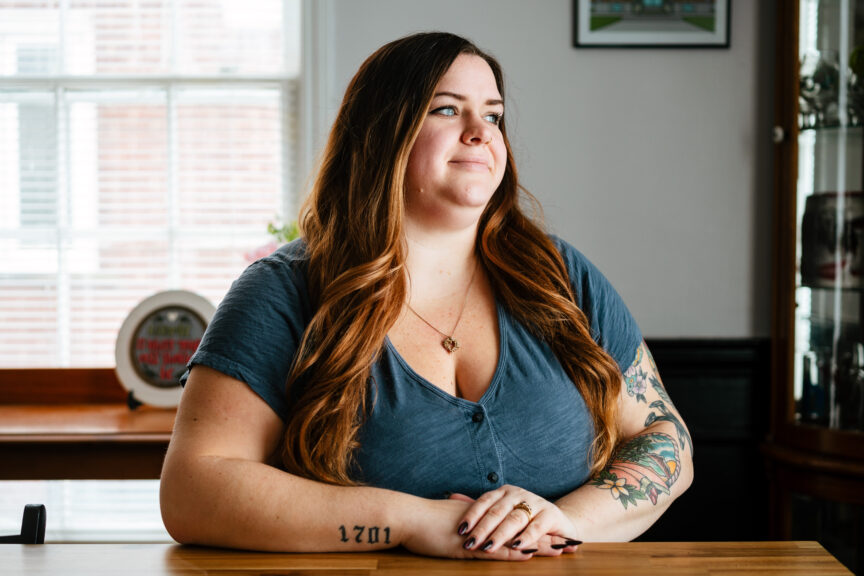
Detroit, MI – January 26, 2023: Marilyn Holewinski Cole poses for a portrait in her home. CREDIT: Nick Hagen for The Southwest Michigan Journalism Collaborative
Marilyn said she discovered an online chat group through the Leukemia & Lymphoma Society that was helpful, but she was the only young adult participant.
“Honest to God, it helps so much to talk to other people who are going through what you’re going through,” she said, but it was difficult at times to relate to older caregivers.
It would have been helpful to have an app that would have allowed her to connect to other caregivers her age, she said, and Claudia could have benefited from peer support, too.
“How do you talk to your friends when you’re a teenager about what’s happening?” Marilyn said. “I know one thing Claudia had a hard time with is that none of her friends could understand what she was going through, at all. So she had this pent-up frustration because nobody understood.
“And she can’t just talk to our mom, because she was in the hospital and asleep 20 hours a day.
“I think both of us felt very alone, even though we were going through it together, because we were at different stages of life and we had different relationships with my mom,” Marilyn said.
Claudia said that she was angry about her mother dying; resentful about how her life had taken this tragic turn, and resistant about being parented by an older sibling. No question, she says now, she could have benefited from a program that would have helped her process her emotions.
“I definitely kept everything inside,” Claudia said. “My friends had absolutely no idea what to do or whether they should talk to me about it. If they did ask me, I would cry and they didn’t want that to happen. Or they would invite me to hang out, but it seemed like I was ignoring them.
“I was just anxious all the time,” she said, unsure of how her mother’s illness would progress and what that would look like, but also conscious of putting on a brave front for her mother “because I didn’t want her to feel worse, and I knew she already felt bad.”
And the fact this was unfolding during her senior year at Kalamazoo Central High School made things even worse, she said. “It felt like, ‘What the hell? Why me? Why now?’
“To have had contact with somebody else who was sort of going through the same sort of thing would have been helpful. Definitely,” Claudia said.
“It’s very hard on your mental health to be a young person taking care of your parent, who’s the one supposed to be taking care of you,” she said. “And you need people to understand what you’re going through.”
About This Story:
This article is part of Overloaded and (Often) Unpaid, a joint solutions journalism project on caregiving and mental wellness between the Southwest Michigan Journalism Collaborative and the New York and Michigan Solutions Journalism Collaborative, a partnership of news and community organizations dedicated to rigorous and compelling reporting about successful responses to social problems. The groups are supported by the Solutions Journalism Network.
More coverage:
- Caregivers and mental health: ‘You’re on overload’
- A cost-effective alternative to nursing homes
- Paid caregiver burnout: How employers can support workers’ mental health
- Resources to help caregivers
Stay Connected:
Subscribe to One Detroit’s YouTube Channel & Don’t miss One Detroit Mondays and Thursdays at 7:30 p.m. on Detroit Public TV, WTVS-Channel 56.
Catch the daily conversations on our website, Facebook, Twitter @DPTVOneDetroit, and Instagram @One.Detroit
View Past Episodes >
Watch One Detroit every Monday and Thursday at 7:30 p.m. ET on Detroit Public TV on Detroit Public TV, WTVS-Channel 56.

